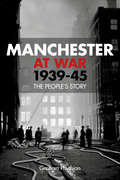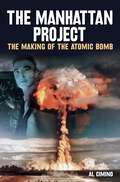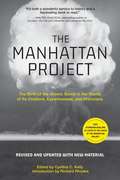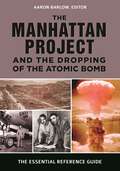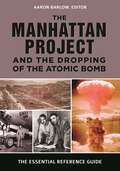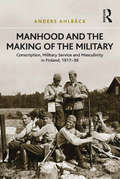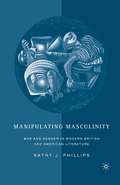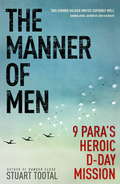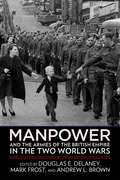- Table View
- List View
Managing Domestic Dissent in First World War Britain (British Politics and Society)
by Brock MillmanThe author argues that the way the British Government managed dissent during World War I is important for understanding the way that the war ended. He argues that a comprehensive and effective system of suppression had been developed by the war's end in 1918, with a greater level in reserve.
Managing Security: Concepts and Challenges (Cass Military Studies)
by Laura R. ClearyThis textbook is designed to be used by those tackling the complex and challenging issues of security sector reform (SSR). The questions of ‘What is security?’ and ‘How can governments deliver it in the most efficient and effective manner?’ are central to this volume. The text explores the ways in which security might be achieved, providing readers with the guiding principles of governance and management. Principles are illustrated through reference to the experiences of countries engaged in reform of their security institutions, allowing the reader to identify continuities and discontinuities in the process of change within the security sector. Written by practitioners for practitioners, the book provides readers with a framework with which to assess and respond to first-, second- and third-generation issues within SSR. All chapters include an introduction to the topic, empirical case studies, and exercises to encourage readers to reflect upon their own experiences of governing and managing security. This book will be of much interest to students of security studies, defence management and defence policy, as well as to practitioners in the field of security management.
Managing Security: Concepts and Challenges (Cass Military Studies)
by Laura R. Cleary Roger DarbyThis textbook is designed to be used by those tackling the complex and challenging issues of security sector reform (SSR). The questions of ‘What is security?’ and ‘How can governments deliver it in the most efficient and effective manner?’ are central to this volume. The text explores the ways in which security might be achieved, providing readers with the guiding principles of governance and management. Principles are illustrated through reference to the experiences of countries engaged in reform of their security institutions, allowing the reader to identify continuities and discontinuities in the process of change within the security sector. Written by practitioners for practitioners, the book provides readers with a framework with which to assess and respond to first-, second- and third-generation issues within SSR. All chapters include an introduction to the topic, empirical case studies, and exercises to encourage readers to reflect upon their own experiences of governing and managing security. This book will be of much interest to students of security studies, defence management and defence policy, as well as to practitioners in the field of security management.
Managing State Fragility: Conflict, Quantification and Power (Routledge Studies in Liberty and Security)
by Isabel Rocha de SiqueiraThis book examines the management of ‘state fragility’ and the practices and impacts of quantification over relations of power in international politics. With the further movement towards quantification, and as technical and technological changes advance, this book argues that certain important quantifying practices can be understood in terms of symbolic power, which is more nuanced and subtle. The aim is that such an understanding can also open space for considering other instances of power that are blurred and nuanced in current international politics. By looking at how the merging of conflict and development issues in the fragile states agenda has been fed by and has fed the authority of ever-perfectible numbers, the book offers an approach to address the difficulty in dealing with profound inequality without presuming domination. Instead, the example of the g7+ group of self-labelled ‘fragile states’ and its tools indicate that quantification has reached a point of no return, but it has done so through indirect practices of management and with the complicity, so to say, of those deemed least favoured by it. This shows that there is little chance that policy-makers and academics can escape dealing with numbers and there is much to be gained by understanding how complex and knowingly imperfect statistics become authoritative and widespread. This book will be of much interest to students of critical security studies, International Political Sociology, development studies, and IR in general.
Managing State Fragility: Conflict, Quantification and Power (Routledge Studies in Liberty and Security)
by Isabel Rocha de SiqueiraThis book examines the management of ‘state fragility’ and the practices and impacts of quantification over relations of power in international politics. With the further movement towards quantification, and as technical and technological changes advance, this book argues that certain important quantifying practices can be understood in terms of symbolic power, which is more nuanced and subtle. The aim is that such an understanding can also open space for considering other instances of power that are blurred and nuanced in current international politics. By looking at how the merging of conflict and development issues in the fragile states agenda has been fed by and has fed the authority of ever-perfectible numbers, the book offers an approach to address the difficulty in dealing with profound inequality without presuming domination. Instead, the example of the g7+ group of self-labelled ‘fragile states’ and its tools indicate that quantification has reached a point of no return, but it has done so through indirect practices of management and with the complicity, so to say, of those deemed least favoured by it. This shows that there is little chance that policy-makers and academics can escape dealing with numbers and there is much to be gained by understanding how complex and knowingly imperfect statistics become authoritative and widespread. This book will be of much interest to students of critical security studies, International Political Sociology, development studies, and IR in general.
Managing the Media in the India-Burma War, 1941-1945
by Philip WoodsThis book explores how the media was used by the armed forces during the India-Burma campaigns of WWII to project the most positive image to domestic and international audiences of a war that often seemed neglected or misunderstood. Discussing how soldiers were, for the first time, able to access newspapers and radio broadcasts relating stories of the campaigns they were actively fighting in, Managing the Media in the India-Burma War reveals not only the impact that the media had in maintaining troop morale, but how the military recognised that the media could be a valuable arm of warfare. Revealing how troops responded to reports of their operations, Philip Woods demonstrates the role of the media in creating the 'Forgotten Army' syndrome, which came about in the last two years of the Burma campaign. Focusing on the British Media, but with examples from the United States and India, including Indian war correspondents, it discusses India's role in the Second World War in relation to social, economic and political developments at the time. Honing in on India and Burma at a turning point in their road to independence, this book offers a fresh angle on a well-known military conflict, unpicks the various constraints and influences on the media in wartime, and links the campaign to India's crucial role in WWII.
Managing the Media in the India-Burma War, 1941-1945
by Philip WoodsThis book explores how the media was used by the armed forces during the India-Burma campaigns of WWII to project the most positive image to domestic and international audiences of a war that often seemed neglected or misunderstood. Discussing how soldiers were, for the first time, able to access newspapers and radio broadcasts relating stories of the campaigns they were actively fighting in, Managing the Media in the India-Burma War reveals not only the impact that the media had in maintaining troop morale, but how the military recognised that the media could be a valuable arm of warfare. Revealing how troops responded to reports of their operations, Philip Woods demonstrates the role of the media in creating the 'Forgotten Army' syndrome, which came about in the last two years of the Burma campaign. Focusing on the British Media, but with examples from the United States and India, including Indian war correspondents, it discusses India's role in the Second World War in relation to social, economic and political developments at the time. Honing in on India and Burma at a turning point in their road to independence, this book offers a fresh angle on a well-known military conflict, unpicks the various constraints and influences on the media in wartime, and links the campaign to India's crucial role in WWII.
Managing the Revolution in Military Affairs
by R. Matthews J. TreddenickThe collapse of the Soviet Union and the end of the Cold War was the catalyst for profound changes in the global security and defence management environment, including: alterations in the size, structure and configuration of the Armed Forces; emergence of asymmetrical warfare; recognition of the strategic significance of military infosphere, embracing all dimensions of the 'virtual' and 'vertical' battlespace; emphasis on coalition warfare and defence-industrial cooperation; and reform of the financial, procurement and logistical systems. The contributors to this book evaluate these environmental changes within a defence management context.
Manchester at War 1939-45: The People's Story
by Graham PhythianThis new book is a remarkable and moving account of life on the home front in Manchester during the Second World War. Based on transcripts of recorded interviews with senior civilians and former members of the Armed Services, this book provides a first-hand narrative of what it was like to live under the shadow of war. The everyday hardships and heroism are recalled: the Blitz, rationing, the Home Guard, evacuees, war work, and the American presence prior to D-Day. Despite all the tragedy and difficulties, the Mancunian spirit shines through with the frequent dash of unquenchable humour. Richly illustrated, and filled with true accounts of local heroism and of the unbreakable spirit of the people of Manchester during these tumultuous years, this book looks at how the city fared during the Second World War, played her part in victory, and how the day-to-day life of her people was affected.
The Manchurian Candidate (Read-along Ser.)
by Richard Condon'Brilliant...wild and exhilarating' New YorkerSgt Raymond Shaw is a hero of the first order. He's an ex-prisoner of war who saved the life of his entire outfit, a winner of the Congressional Medal of Honor, the stepson of an influential senator...and the perfect assassin. Brainwashed during his time as a POW he is a 'sleeper', a living weapon to be triggered by a secret signal. He will act without question, no matter what order he is made to carry out. To stop Shaw, his former commanding officer must uncover the truth behind a twisted conspiracy of torture, betrayal and power that will lead both to the highest levels of the government. - and to Shaw's own past...
Maneuvers: The International Politics Of Militarizing Women's Lives
by Cynthia EnloeManeuvers takes readers on a global tour of the sprawling process called "militarization." With her incisive verve and moxie, eminent feminist Cynthia Enloe shows that the people who become militarized are not just the obvious ones-executives and factory floor workers who make fighter planes, land mines, and intercontinental missiles. They are also the employees of food companies, toy companies, clothing companies, film studios, stock brokerages, and advertising agencies. Militarization is never gender-neutral, Enloe claims: It is a personal and political transformation that relies on ideas about femininity and masculinity. Films that equate action with war, condoms that are designed with a camouflage pattern, fashions that celebrate brass buttons and epaulettes, tomato soup that contains pasta shaped like Star Wars weapons-all of these contribute to militaristic values that mold our culture in both war and peace.Presenting new and groundbreaking material that builds on Enloe's acclaimed work in Does Khaki Become You? and Bananas, Beaches, and Bases, Maneuvers takes an international look at the politics of masculinity, nationalism, and globalization. Enloe ranges widely from Japan to Korea, Serbia, Kosovo, Rwanda, Britain, Israel, the United States, and many points in between. She covers a broad variety of subjects: gays in the military, the history of "camp followers," the politics of women who have sexually serviced male soldiers, married life in the military, military nurses, and the recruitment of women into the military. One chapter titled "When Soldiers Rape" explores the many facets of the issue in countries such as Chile, the Philippines, Okinawa, Rwanda, and the United States.Enloe outlines the dilemmas feminists around the globe face in trying to craft theories and strategies that support militarized women, locally and internationally, without unwittingly being militarized themselves. She explores the complicated militarized experiences of women as prostitutes, as rape victims, as mothers, as wives, as nurses, and as feminist activists, and she uncovers the "maneuvers" that military officials and their civilian supporters have made in order to ensure that each of these groups of women feel special and separate.
The Manhattan Project: The Making of the Atomic Bomb
by Al CiminoThe ramifications of the Manhattan Project are still with us to this day. The atomic bombs that came out of it brought an end to the war in the Pacific, but at a heavy loss of life in Japan and the opening of a Pandora's box that has tested international relations.This book traces the history of the Manhattan Project, from the first glimmerings of the possibility of such a catastrophic weapon to the aftermath of the bombings of Hiroshima and Nagasaki. It profiles the architects of the bomb and how they tried to reconcile their personal feelings with their ambition as scientists. It looks at the role of the politicians and it includes first-hand accounts of those who experienced the effects of the bombings.
Manhattan Project: The Birth of the Atomic Bomb in the Words of Its Creators, Eyewitnesses, and Historians
by Cynthia C. KellyThe definitive collection of writings on the Manhattan Project by the pre-eminent scientists, historians, and the everyday observers who bore witness to the birth of the modern nuclear age.Begun in 1939, the Manhattan Project eventually employed more than 130,000 people, including our foremost scientists and thinkers, and cost nearly $2 billion, while operating under a shroud of absolute secrecy. This groundbreaking collection of documents, essays, articles, and excerpts from histories, biographies, plays, novels, letters, and the oral histories of key eyewitnesses provides unique perspectives for the historian and student of history all compiled by experts at the Atomic Heritage Foundation. Photographs throughout depict key moments and pivotal figures. The Manhattan Project gives actual voice to a significant period in history.
The Manhattan Project: The Birth of the Atomic Bomb in the Words of Its Creators, Eyewitnesses, and Historians
by Richard Rhodes Cynthia C. KellyOn the seventy-fifth anniversary of the first atomic bomb, discover new reflections on the Manhattan Project from President Barack Obama, hibakusha (survivors), and the modern-day mayors of Hiroshima and Nagasaki.The creation of the atomic bomb during World War II, codenamed the Manhattan Project, was one of the most significant and clandestine scientific undertakings of the 20th century. It forever changed the nature of war and cast a shadow over civilization. Born out of a small research program that began in 1939, the Manhattan Project would eventually employ nearly 600,000 people and cost about $2 billon ($28.5 billion in 2020) -- all while operating under a shroud of complete secrecy. On the 75th anniversary of this profoundly crucial moment in history, this newest edition of The Manhattan Project is updated with writings and reflections from the past decade and a half. This groundbreaking collection of essays, articles, documents, and excerpts from histories, biographies, plays, novels, letters, and oral histories remains the most comprehensive collection of primary source material of the atomic bomb.
The Manhattan Project and the Dropping of the Atomic Bomb: The Essential Reference Guide
by Aaron BarlowThis invaluable resource offers students a comprehensive overview of the Manhattan Project and the decision to drop the atomic bomb, with more than 80 in-depth articles on a variety of topics and dozens of key primary source documents.This book provides everything readers need to know about the Manhattan Project, the U.S. program that led to the development of the atomic bomb during World War II. It begins with a detailed introduction to the project and includes an alphabetical collection of relevant entries on such topics as the Enola Gay, the first aircraft to drop an atomic bomb; Enrico Fermi, creator of the first nuclear reactor; Hiroshima, the target of the first atomic bomb; and Robert Oppenheimer, director of the Manhattan Project.Dozens of primary sources include eyewitness accounts, government memos, letters, press releases, and other important documents relevant to the establishment and success of the Manhattan Project. A set of four essays written by prominent scholars address whether the United States was justified in dropping the atomic bomb on Japan. The book also includes a comprehensive chronology that reveals key moments related to the creation of the world's first nuclear weapon as well as a bibliography of resources that points readers toward additional information on the Manhattan Project, nuclear weapons, and World War II.
The Manhattan Project and the Dropping of the Atomic Bomb: The Essential Reference Guide
by Aaron BarlowThis invaluable resource offers students a comprehensive overview of the Manhattan Project and the decision to drop the atomic bomb, with more than 80 in-depth articles on a variety of topics and dozens of key primary source documents.This book provides everything readers need to know about the Manhattan Project, the U.S. program that led to the development of the atomic bomb during World War II. It begins with a detailed introduction to the project and includes an alphabetical collection of relevant entries on such topics as the Enola Gay, the first aircraft to drop an atomic bomb; Enrico Fermi, creator of the first nuclear reactor; Hiroshima, the target of the first atomic bomb; and Robert Oppenheimer, director of the Manhattan Project.Dozens of primary sources include eyewitness accounts, government memos, letters, press releases, and other important documents relevant to the establishment and success of the Manhattan Project. A set of four essays written by prominent scholars address whether the United States was justified in dropping the atomic bomb on Japan. The book also includes a comprehensive chronology that reveals key moments related to the creation of the world's first nuclear weapon as well as a bibliography of resources that points readers toward additional information on the Manhattan Project, nuclear weapons, and World War II.
Manhood and the Making of the Military: Conscription, Military Service and Masculinity in Finland, 1917–39
by Anders AhlbäckWhen Finland gained its independence from Russia in 1917, the country had not had a military for almost two decades. The ensuing creation of a new national conscript army aroused intense but conflicting emotions among the Finns. This book examines how a modern conscript army, born out of a civil war, had to struggle through social, cultural and political minefields to find popular acceptance. Exploring the ways that images of manhood were used in the controversies, it reveals the conflicts surrounding compulsory military service in a democratic society and the compromises made as the new nation had to develop the will and skill to defend itself. Through the lens of masculinity, another picture of conscription emerges, offering new understandings of why military service was resisted and supported, dreaded and celebrated in Finnish society. Intertwined with the story of the making of the military runs the story of how manhood was made and remade through the idealized images and real-life experiences of conscripted soldiers. Placing interwar Finland within a broad European context, the book traces the origins of competing military traditions and ideological visions of modern male citizenship back to their continental origins. It contributes to the need for studies on the impact of the Great War on masculinities and constructions of gender among military cultures in the peacetime period between the two world wars.
Manhood and the Making of the Military: Conscription, Military Service and Masculinity in Finland, 1917–39
by Anders AhlbäckWhen Finland gained its independence from Russia in 1917, the country had not had a military for almost two decades. The ensuing creation of a new national conscript army aroused intense but conflicting emotions among the Finns. This book examines how a modern conscript army, born out of a civil war, had to struggle through social, cultural and political minefields to find popular acceptance. Exploring the ways that images of manhood were used in the controversies, it reveals the conflicts surrounding compulsory military service in a democratic society and the compromises made as the new nation had to develop the will and skill to defend itself. Through the lens of masculinity, another picture of conscription emerges, offering new understandings of why military service was resisted and supported, dreaded and celebrated in Finnish society. Intertwined with the story of the making of the military runs the story of how manhood was made and remade through the idealized images and real-life experiences of conscripted soldiers. Placing interwar Finland within a broad European context, the book traces the origins of competing military traditions and ideological visions of modern male citizenship back to their continental origins. It contributes to the need for studies on the impact of the Great War on masculinities and constructions of gender among military cultures in the peacetime period between the two world wars.
Manifest Ambition: James K. Polk and Civil-Military Relations during the Mexican War (In War and in Peace: U.S. Civil-Military Relations)
by John C. PinheiroThis is not another chronological retelling of the Mexican War. Instead, it examines civil-military clashes during the war in light of Jacksonian politics and the American citizen-soldier tradition, looking at events that shed light on civilian authority over the military, as well as the far reaching impact of political ambition during this period (specifically, presidential power and the quest for the presidency). By 1848, Americans had come to realize that in their burgeoning democracy, generals and politicians could scarcely resist the temptation to use war for partisan gain. It was a lesson well learned and one that still resonates today.The Mexican War is known for the invaluable experience it provided to future Civil War officers and as an example of America's drive to fulfill her Manifest Destiny. Yet it was more than a training ground, more than a display of imperialism. Significantly, the Mexican War tested civilian control of the military and challenged traditional assumptions about the role of the army in American society. In so doing, it revealed the degree to which, by 1846, the harsh partisanships of the Jacksonian Era had impacted the American approach to war. This is not another chronological retelling of the Mexican War. Instead, it examines civil-military clashes during the war in light of Jacksonian politics and the American citizen-soldier tradition, looking both at events that shed light on civilian authority over the military and at the far reaching impact of political ambition during this period (specifically, presidential power and the quest for the presidency).In addition to politics, a host of others factors marred civil-military relations during the war, threatening U.S. victory. These included atrocities committed by Americans against Mexicans, disobedient officers, and inefficient U.S. military governors. In the end, as Manifest Ambition shows, Polk's ability to overcome his partisan leanings, his micro-management of the war effort, and his overall strategic vision, helped avoid both a prolonged occupation and the annexation of All Mexico. By 1848, Americans had come to realize that in their burgeoning democracy, generals and politicians could scarcely resist the temptation to use war for partisan gain. It was a lesson well learned and one that still resonates today.
Manipulating Masculinity: War and Gender in Modern British and American Literature
by K. PhillipsIn this study, Kathy Janette Phillips uses literature from World War I, World War II, the Vietnam War and the Iraq wars to argue that labelling broadly human traits 'feminine' helps societies manipulate men to war. Phillips also shows that damning pleasure fuels wars by encouraging the displacement of sexuality into violence.
The Manner of Men: 9 PARA's Heroic D-Day Mission
by Stuart TootalIn June 1944, an elite unit of British paratroopers was sent on a daring and highly risky behind-the-lines mission, which was deemed vital to the success of D-Day. Dropping ahead of the main Allied invasion, 9 PARA were tasked with destroying an impregnable German gun battery. If they failed, thousands of British troops landing on the beaches were expected to die. But their mission was flawed and started to go wrong from the moment they jumped from their aircraft above Normandy. Only twenty per cent of the unit made it to the objective and half of them were killed or wounded during the attack. Undermanned and lacking equipment and ammunition, the survivors then held a critical part of the invasion beachhead. For six bloody days, they defended the Breville Ridge against vastly superior German forces and bore the brunt of Rommel's attempt to turn the left flank of the Allied invasion.The Manner of Men is an epic account of courage beyond the limits of human endurance, where paratroopers prevailed despite intelligence failures and higher command blunders, in what has been described as one of the most remarkable feat of arms of the British Army and the Parachute Regiment during the Second World War.
The Mannerheim Line 1920–39: Finnish Fortifications of the Winter War (Fortress)
by Brian Delf Bair IrincheevIn the wake of the bloody civil war that followed Finland's independence from Russia in 1917, the border between the two countries was established across the Karelian Isthmus, an area long fought over by Russia, Finland and Sweden in their attempts to dominate the northern tip of Europe. Neither the Soviets nor the Finnish were comfortable with such a divide which was only 32km from the military and industrial city of Petrograd. As such, both sides began an intensive period of fortification and defensive planning. As the Winter War broke out in November 1939, the complex and heavily defended Mannerheim Line suffered intense bombardment. The armistice of 1940 saw Finland cede control of the entire Karelian Isthmus to the USSR, and a propaganda war ensued. Through an analysis of the background, and operational history of the Mannerheim Line, Bair Irincheev attempts to dispel such myths and provide an accurate assessment of its huge historical importance.
The Mannerheim Line 1920–39: Finnish Fortifications of the Winter War (Fortress #88)
by Brian Delf Bair IrincheevIn the wake of the bloody civil war that followed Finland's independence from Russia in 1917, the border between the two countries was established across the Karelian Isthmus, an area long fought over by Russia, Finland and Sweden in their attempts to dominate the northern tip of Europe. Neither the Soviets nor the Finnish were comfortable with such a divide which was only 32km from the military and industrial city of Petrograd. As such, both sides began an intensive period of fortification and defensive planning. As the Winter War broke out in November 1939, the complex and heavily defended Mannerheim Line suffered intense bombardment. The armistice of 1940 saw Finland cede control of the entire Karelian Isthmus to the USSR, and a propaganda war ensued. Through an analysis of the background, and operational history of the Mannerheim Line, Bair Irincheev attempts to dispel such myths and provide an accurate assessment of its huge historical importance.
Manning the Future Legions of the United States: Finding and Developing Tomorrow's Centurions (Contemporary Military, Strategic, and Security Issues)
by Donald VandergriffAn Industrial Age model continues to shape the way the Army approaches its recruiting, personnel management, training, and education. This outdated personnel management paradigm—designed for an earlier era—has been so intimately tied to the maintenance of Army culture that a self-perpetuating cycle has formed, diminishing the Army's attempts to develop adaptive leaders and institutions.This cycle can be broken only if the Army accepts rapid evolutionary change as the norm of the new era. Recruiting the right people, then having them step into an antiquated organization, means that many of them will not stay as they find their ability to contribute and develop limited by a centralized, hierarchical organization. Recruiting and retention data bear this out.Several factors have combined to force the Army to think about the way it develops and nurtures its leaders. Yet, Vandergriff maintains, mere modifications to today's paradigm may not be enough. Today's Army has to do more than post rhetoric about adaptability on briefing slides and in literature. One cannot divorce the way the Army accesses, promotes, and selects its leaders from its leadership-development model. The Army cannot expect to maintain leaders who grasp and practice adaptability if these officers encounter an organization that is neither adaptive nor innovative. Instead, Army culture must become adaptive, and the personnel system must evolve into one that nurtures adaptability in its policies, practices, and beliefs. Only a detailed, comprehensive plan where nothing is sacred will pave the way to cultural evolution.
Manpower and the Armies of the British Empire in the Two World Wars
by Douglas E. Delaney, Mark Frost, and Andrew L. BrownIn the first and only examination of how the British Empire and Commonwealth sustained its soldiers before, during, and after both world wars, a cast of leading military historians explores how the empire mobilized manpower to recruit workers, care for veterans, and transform factory workers and farmers into riflemen. Raising armies is more than counting people, putting them in uniform, and assigning them to formations. It demands efficient measures for recruitment, registration, and assignment. It requires processes for transforming common people into soldiers and then producing officers, staffs, and commanders to lead them. It necessitates balancing the needs of the armed services with industry and agriculture. And, often overlooked but illuminated incisively here, raising armies relies on medical services for mending wounded soldiers and programs and pensions to look after them when demobilized.Manpower and the Armies of the British Empire in the Two World Wars is a transnational look at how the empire did not always get these things right. But through trial, error, analysis, and introspection, it levied the large armies needed to prosecute both wars.Contributors Paul R. Bartrop, Charles Booth, Jean Bou, Daniel Byers, Kent Fedorowich, Jonathan Fennell, Meghan Fitzpatrick, Richard S. Grayson, Ian McGibbon, Jessica Meyer, Emma Newlands, Kaushik Roy, Roger Sarty, Gary Sheffield, Ian van der Waag






